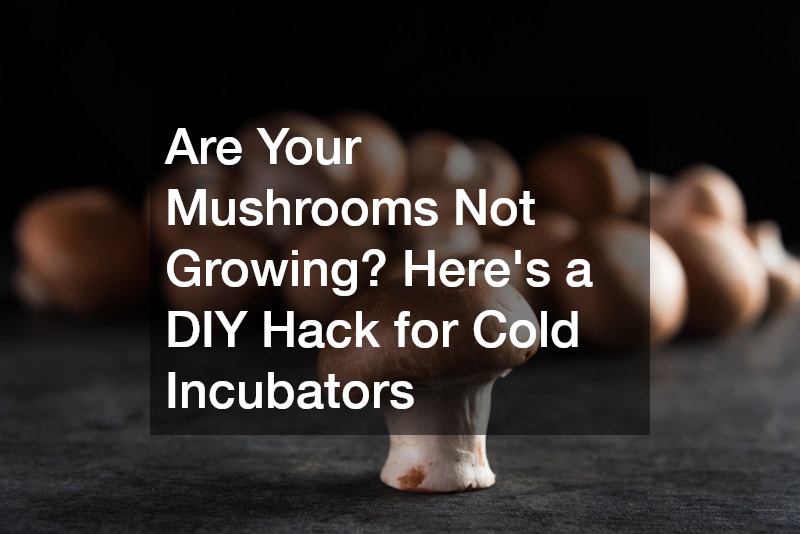
Growing mushrooms at home can be a rewarding experience, but it often comes with challenges. One common issue home cultivators face is a cold incubation environment, which can stall the growth of mushrooms. In this article, we’ll explore a DIY hack to help you combat this problem and boost your mushroom-growing success.
Understanding the Ideal Conditions for Mushroom Growth
Importance of Temperature Control
Temperature is a critical factor in mushroom growth, influencing metabolic processes. If the incubation environment is too cold, it can slow or halt mushroom growth.
Therefore, maintaining an optimal temperature is essential to keeping the mycelium active and the mushrooms growing.
The ideal temperature range for effective mushroom cultivation typically falls between 65-75°F (18-24°C). Within this temperature range, the mycelium, the vegetative part of the fungi, can thrive and continue its development. By ensuring that these conditions are met, cultivators can avoid common growth issues related to temperature.
Fluctuations in temperature can also impact the growth rate and quality of mushrooms. Maintaining a consistent temperature ensures a healthy and bountiful harvest. Implementing temperature control measures can lead to increased yields and successful cultivation.
Humidity’s Role in Incubation Success
Humidity is another crucial factor affecting mushroom development and overall yield. A proper balance of humidity ensures the mycelium does not dry out and helps create an ideal environment for mushroom formation. Insufficient humidity levels can lead to smaller or deformed mushrooms, affecting crop quality.
The recommended humidity level for most mushroom species during incubation is 85-95%. This moisture level in the air helps keep the substrate and developing mushrooms hydrated. A controlled environment with proper humidity leads to consistent and optimized growth conditions.
Inadequate humidity can result in slower growth or fruit failure, as mushrooms require sufficient moisture to expand. Monitoring and adjusting humidity levels can improve outcomes. Keeping the incubator environment stable is key for successful cultivation and abundant harvests.
Light Considerations for Mushroom Cultivation
While mushrooms do not require light for photosynthesis, some light exposure can positively impact their growth. Light can trigger the fruiting process in some mushroom species when used appropriately. However, too much light can be detrimental and needs to be carefully controlled during incubation.
Most mushroom species grow well in low-light conditions with some indirect sunlight or artificial light. Controlled light exposure can help align the growth cycle of mushrooms and signal when it is time to fruit. This balance is necessary to avoid initiating premature fruiting or retarding the growth process.
Understanding species-specific light needs is vital for cultivators aiming for optimal results. Different mushrooms may have varying light requirements, and adjusting to these can enhance crop health. Adapting the incubation environment to these requirements will lead to successful harvests.

DIY Solutions to Combat Cold Incubation
Creating a Low-Cost Heat Source
For those experiencing issues with cold incubators, creating a low-cost heat source can make a significant difference. One effective method is using a simple incandescent bulb to generate heat inside the incubator. This solution is both cost-effective and easy to implement.
Another approach is using heat mats or heating cables, often employed in plant propagation. These devices provide consistent warmth and can be managed with a thermostat for precision. Incorporating these into your setup can help maintain the ideal temperature range for mushroom growth.
Consider placing warm water bottles or heating pads within the incubation space for more DIY methods. Insulating materials can help retain this warmth and prevent heat loss. These strategies, when combined, can effectively improve the cultivation environment.
Insulating Your Incubation Environment
Insulation is an essential consideration for those struggling with cold incubation environments. Materials like reflective bubble wrap or foam panels can significantly enhance an incubator’s heat retention. Proper insulation ensures that the warmth generated by heat sources is retained efficiently.
Sealing gaps and crevices in the incubation space is equally significant in maintaining consistent temperatures. Weather stripping or caulk can seal these gaps and prevent cold air infiltration. Effective insulation minimizes the energy required to heat the space, making the process more efficient.
Combining these insulation techniques with a reliable heat source can create a balanced environment for mushrooms to thrive. The goal is to maintain steady conditions that align with optimal growth requirements. Insulation contributes to the stability and overall success of the cultivation effort.
Monitoring and Adjusting Your Setup
Continually monitoring the incubation setup is crucial to maintaining ideal conditions. Digital thermometers or hygrometers can provide real-time data on the incubator’s environment. This information allows cultivators to make necessary adjustments promptly.
Adjustments may include modifying the heat source, humidity levels, or light exposure based on the current conditions. Regular checks can prevent unexpected issues and optimize the growth environment over time. Cultivators should keep records of environmental parameters to detect patterns and make informed decisions.
Maintenance and monitoring bolster the chances of high-quality and high-yield mushroom cultivation. Through observation and adaptation, home growers can successfully address the challenges of cold incubation. Consistency in monitoring plays a pivotal role in sustained cultivation success.
Home cultivators can significantly improve their mushroom yields by understanding the ideal conditions for mushroom growth and implementing simple DIY methods to combat cold incubation. Experimenting with these hacks can lead to successful harvests and a more sustainable mushroom-growing venture. This knowledge and these solutions empower cultivators to face challenges and achieve their cultivation goals confidently.



